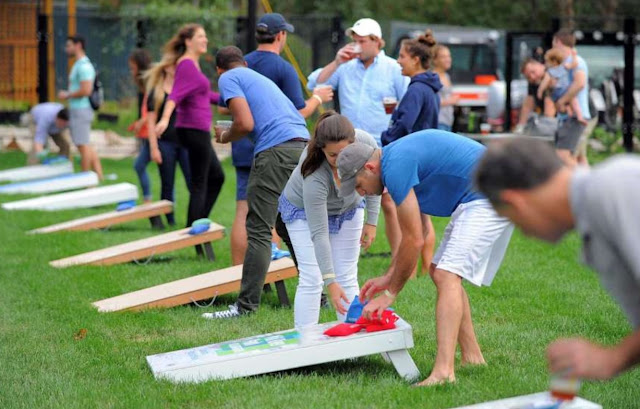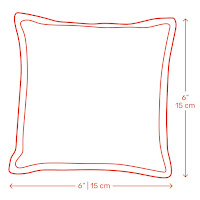Cornhole is a very simple and fun game. Toss the bag through the hole. But when you dig a little deeper, there are an abundance of rules and regulations. If you want to be official and have regulation cornhole bags, you need to take the following things according to American Cornhole Association (ACA) into consideration.
Cornhole, also known as bean bags, baggo, bags, or sack toss, is a common lawn game where players (singles or teams of two) throw bean bags at a hole on an angled board to score points. Players score three points for throwing a bag through the hole, and one point for each that lands on the platform.
Modern cornhole was invented in 1883 as a game called 'Parlor Quoits' that substituted horseshoes with bean-bags so that the game could be played indoors. Variety of venues that typically include backyards, bars, breweries, camp sites, and tailgating events. Cornhole has gained popularity for a variety of reasons that may include the simplicity of the game rules, the social nature of competing in teams or watching others play, and the ease of transporting the required game equipment.
Regulation cornhole bags need to be 6-inches square and should weigh between 14-16 oz. Today are typically filled with plastic pellets, but traditional cornhole bags filled with corn kernels are still popularly used. Its name because the bags used to play the game were originally filled with corn kernels.
Lets go to the Regulation And Rules
DIMENSIONS
A cornhole court shall be a level rectangular area 8-10 feet wide and a minimum of 40-45 feet long. The court should consist of two cornhole boards, designated pitcher’s boxes, and foul lines.
PITCHER'S BOX
The pitcher’s box is the rectangle 4 feet by 3 feet at each end of the court, parallel with, and on both sides of the boards. Each player must remain in the pitcher’s box while pitching a cornhole bag.
FOUL LINES
There are two sets of foul lines: open adult-play and junior-play for children 12 and under. The adult foul lines shall be defined as an imaginary line 27 feet between the front of each board. The junior-play foul lines are defined as an imaginary line 12-15 feet between the front of each board. The foul line should be parallel to the front of the opposite board to meet ACA guidelines.
The ACA has adopted the following equipment specifications and standards:
1. Each board shall be a 47.5 to 48 inch by 23.5 to 24 inch rectangle made of plywood that is at least a 0.5 inch thick. ACA sanctioned cornhole tournaments should only be played with wooden boards, as there is significant variance in play between wooden, plastic, and other surfaces.
2. The hole in the board shall be 6 inches in diameter. Its center shall be 9 inches from the top and 12 inches from each side of the board edges.
3. The front of the board shall be 3-4 inches from bottom to top.
4. The back of the board shall be approximately 12 inches from ground to the highest point of the deck.
5. The board finish shall be sanded to a very smooth texture, and there shall not be any blemishes in the wood surface that might disrupt or distort play.
6. The board can be painted with a semi-gloss exterior latex paint resulting in a surface that allows bags to slide, but is not so slippery that it allows the bags to slide back down the board.
7. The cornhole bags shall be made from two fabric squares 6.25 square inches with a 0.25 inch stitched seam on all four sides. Bags should be made from durable fabric. Each bag shall be filled with approximately 2 cups of feed corn and finished bags should be roughly 6 square inches and weigh 14-16 ounces. ACA will allow the use of plastic pellets (All Weather Cornhole Bags) in lieu of feed corn. ACA offers both Corn-Filled and All Weather cornhole bags.
Every cornhole match is broken down into innings of play. During an inning of play, each player must pitch all four of his/her bags. An inning is never completed until all players pitch all four of his/her bags.
The cornhole game shall be played to the predetermined number of twenty-one points. The first player/team to reach (or exceed) that amount at the conclusion of an inning is the winner.
Do you have any regulation cornhole bags questions we left off the list? Share your concerns with us!
Cornhole, also known as bean bags, baggo, bags, or sack toss, is a common lawn game where players (singles or teams of two) throw bean bags at a hole on an angled board to score points. Players score three points for throwing a bag through the hole, and one point for each that lands on the platform.
Modern cornhole was invented in 1883 as a game called 'Parlor Quoits' that substituted horseshoes with bean-bags so that the game could be played indoors. Variety of venues that typically include backyards, bars, breweries, camp sites, and tailgating events. Cornhole has gained popularity for a variety of reasons that may include the simplicity of the game rules, the social nature of competing in teams or watching others play, and the ease of transporting the required game equipment.
Regulation cornhole bags need to be 6-inches square and should weigh between 14-16 oz. Today are typically filled with plastic pellets, but traditional cornhole bags filled with corn kernels are still popularly used. Its name because the bags used to play the game were originally filled with corn kernels.
Lets go to the Regulation And Rules
CORNHOLE GAME COURT LAYOUT
DIMENSIONS
A cornhole court shall be a level rectangular area 8-10 feet wide and a minimum of 40-45 feet long. The court should consist of two cornhole boards, designated pitcher’s boxes, and foul lines.
PITCHER'S BOX
The pitcher’s box is the rectangle 4 feet by 3 feet at each end of the court, parallel with, and on both sides of the boards. Each player must remain in the pitcher’s box while pitching a cornhole bag.
FOUL LINES
There are two sets of foul lines: open adult-play and junior-play for children 12 and under. The adult foul lines shall be defined as an imaginary line 27 feet between the front of each board. The junior-play foul lines are defined as an imaginary line 12-15 feet between the front of each board. The foul line should be parallel to the front of the opposite board to meet ACA guidelines.
STANDARDS REGULATIONS FOR CORNHOLE BOARDS AND BAGS
The ACA has adopted the following equipment specifications and standards:
1. Each board shall be a 47.5 to 48 inch by 23.5 to 24 inch rectangle made of plywood that is at least a 0.5 inch thick. ACA sanctioned cornhole tournaments should only be played with wooden boards, as there is significant variance in play between wooden, plastic, and other surfaces.
2. The hole in the board shall be 6 inches in diameter. Its center shall be 9 inches from the top and 12 inches from each side of the board edges.
3. The front of the board shall be 3-4 inches from bottom to top.
4. The back of the board shall be approximately 12 inches from ground to the highest point of the deck.
5. The board finish shall be sanded to a very smooth texture, and there shall not be any blemishes in the wood surface that might disrupt or distort play.
6. The board can be painted with a semi-gloss exterior latex paint resulting in a surface that allows bags to slide, but is not so slippery that it allows the bags to slide back down the board.
7. The cornhole bags shall be made from two fabric squares 6.25 square inches with a 0.25 inch stitched seam on all four sides. Bags should be made from durable fabric. Each bag shall be filled with approximately 2 cups of feed corn and finished bags should be roughly 6 square inches and weigh 14-16 ounces. ACA will allow the use of plastic pellets (All Weather Cornhole Bags) in lieu of feed corn. ACA offers both Corn-Filled and All Weather cornhole bags.
THE CORNHOLE GAME RULES
Every cornhole match is broken down into innings of play. During an inning of play, each player must pitch all four of his/her bags. An inning is never completed until all players pitch all four of his/her bags.
The cornhole game shall be played to the predetermined number of twenty-one points. The first player/team to reach (or exceed) that amount at the conclusion of an inning is the winner.
Singles Play - Player A competes against Player B.
1. Both players stay in their designated lane for the whole game.
2. Players start the game at the headboard and will alternate pitching bags until each player has pitched all four of his/her bags.
3. Players then walk to the end of their lane to the other court, take score, and resume pitching back to the other board.
4. The top of an inning is completed when the first player pitches all four bags; the bottom of the inning is completed when the remaining player pitches all four bags.
1. Both players stay in their designated lane for the whole game.
2. Players start the game at the headboard and will alternate pitching bags until each player has pitched all four of his/her bags.
3. Players then walk to the end of their lane to the other court, take score, and resume pitching back to the other board.
4. The top of an inning is completed when the first player pitches all four bags; the bottom of the inning is completed when the remaining player pitches all four bags.
Doubles Play - Team A competes against Team B; each team is comprised of two people.
1. Each team will stay in their designated lane for the whole game.
2. Players at the headboard will alternate pitching bags until each player has pitched all four of his/her bags.
3. Players at the footboard will take score and resume pitching back to the other board.
4. The top of an inning is completed when both players pitching from the headboard pitch all four bags; the bottom of the inning is completed when the remaining players pitching from the footboard pitch all four bags.
1. Each team will stay in their designated lane for the whole game.
2. Players at the headboard will alternate pitching bags until each player has pitched all four of his/her bags.
3. Players at the footboard will take score and resume pitching back to the other board.
4. The top of an inning is completed when both players pitching from the headboard pitch all four bags; the bottom of the inning is completed when the remaining players pitching from the footboard pitch all four bags.
Do you have any regulation cornhole bags questions we left off the list? Share your concerns with us!


